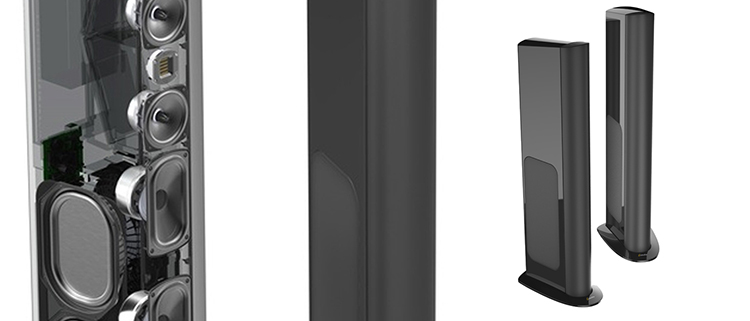
GoldenEar has managed to slide their new Triton One.R in between the Triton Reference and the Triton One. The One.R is the quintessential version that combines the best of both versions – the size of the Triton One and the looks and performance of the Reference. Although still a large speaker, the Triton One (dot) R doesn’t feel dominant within the space like the Reference Triton but it sure can deliver most of the performance of the larger sibling.

GoldenEar Triton One.R Tower Speakers
- Affordable version of the Triton Reference
- Powered subwoofer
- New Triton design with glossy finished panels
- Forgiving placement
- Excellent dynamic range

Having reviewed both the Triton One and the Reference, and having itched to keep them both, I may have decided the (unexpected) wait for the One.R was in the cards. Physically and sonically, the scale of the Triton One.R suits my listening space. Just right…
Dimensions:
(height is with base installed, no spikes)
5-3/4˝ W (at face), 8” (at rear) x 16-5/8” D x 54˝ H
Base:
12-3/8” W x 19-3/4˝ D
Weight:
80 lbs (each)
Frequency Response:
13 Hz – 35 kHz
Efficiency:
92 dB
Nominal Impedance:
Compatible with 8 ohms
Driver Complement
Three:
5” x 9” Long-Throw Quadratic Reference Subwoofers
Four:
7” x 10˝ Quadratic Planar Infrasonic Radiators
Two:
5 ¼” High-Definition Cast-Basket MVPP™ Focused Field Upper-Bass. Mid Drivers
One:
High Gauss Reference High-Velocity Folded Ribbon (HVFR™) Tweeter
Built-In Subwoofer
Power Amplification:
1600 watt with 56-bit DSP SuperSub Amplifier
MSRP:
$3,299 each
Company:
SECRETS Tags:
GoldenEar, Triton One.R, Triton, One.R, Tower, Tower Speakers, Speakers Speaker Review 2019
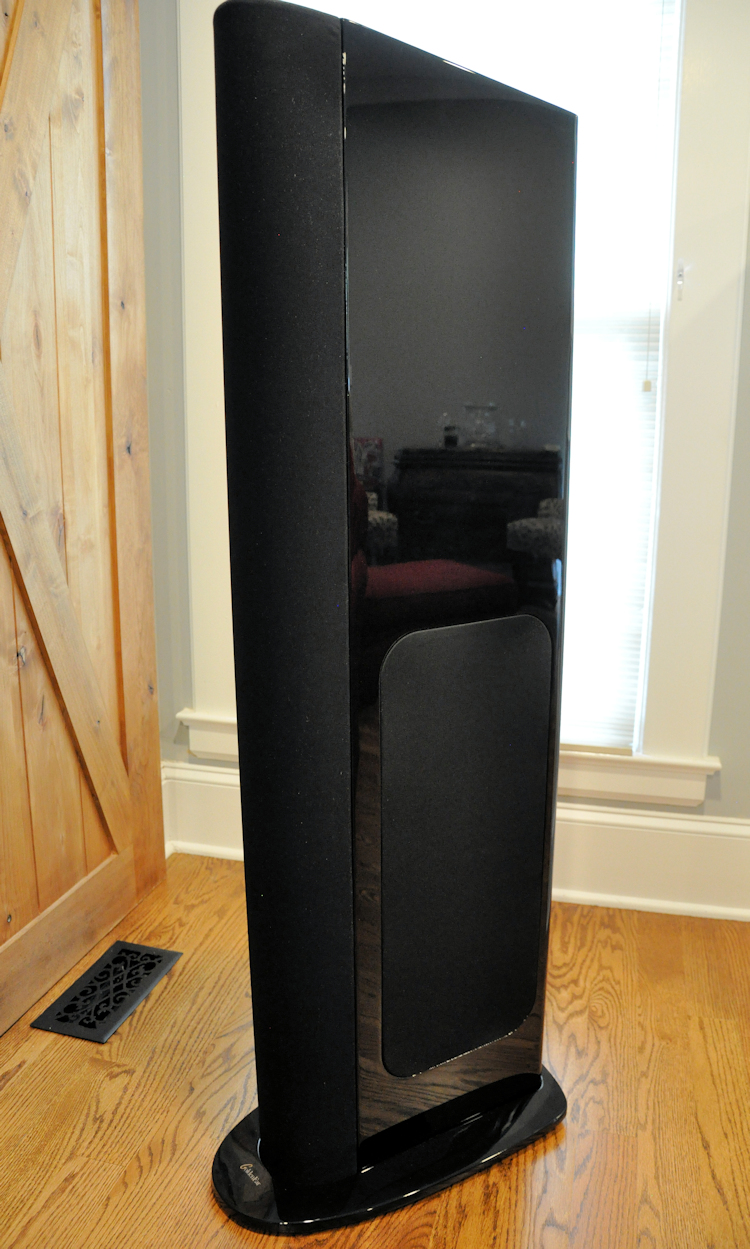
Luckily for me, the new Triton One.R doesn’t stray much from the formula that has been developed successfully in the master plan that is Triton. With the emergence of the newly evolved design that includes the cabinet and the updated drivers, GoldenEar set out to develop an affordable version of the Reference. Some may argue the Triton Reference is already a benchmark for affordability, confidently competing with many higher-priced speakers, matching them in performance and sound.
The Triton One.R captures the essence of the Reference in many ways, styling is the first of note. The sides are high-gloss, lacquer-coated black panels, unlike the majority of the Triton line that is head-to-toe covered in black stocking. For me, this appearance is a major aesthetic upgrade.
Secrets Sponsor
The speaker nonetheless is imposingly large, standing four and half feet tall and quite deep at almost 17 inches. The familiar logo-adorned, wide and glossy base keeps the tall speaker from tipping. Most of the weight of the speaker is low, with the bass-driver and amplifier down at the bottom.
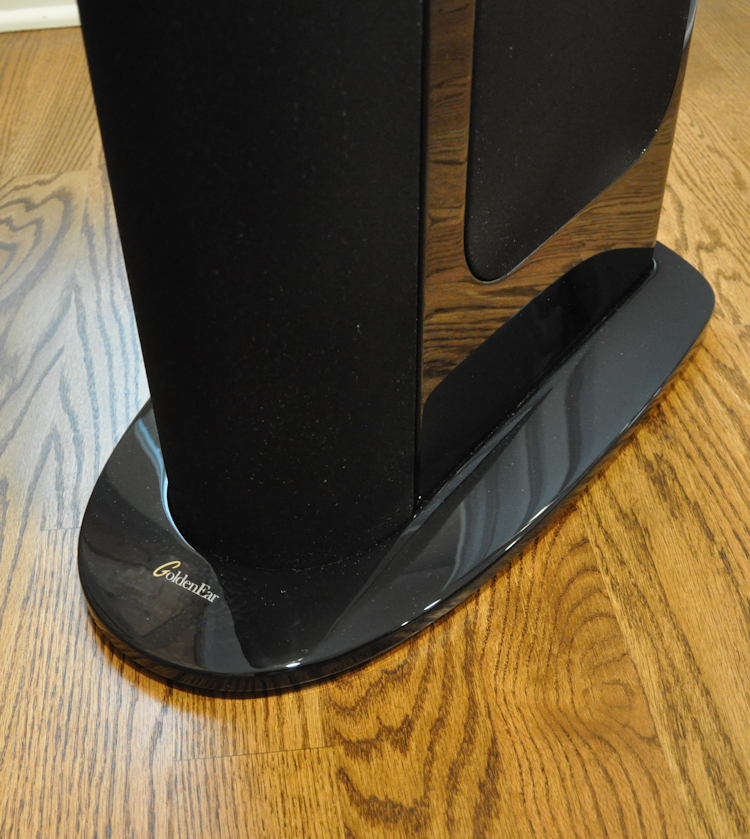
What may not be obvious are the updated drivers based on the new Reference models, and by updated I refer to the current Triton One complement of drivers. The built-in, 1600-watt, 56-bit DSP-controlled, digital amplifier is the same one found on their SuperSub stand-alone subwoofer. The racetrack drivers are 5” X 9” and coupled to two, 7” X 10” passive radiators on each side, mounted in a balanced configuration, to minimize the effect on the cabinet.
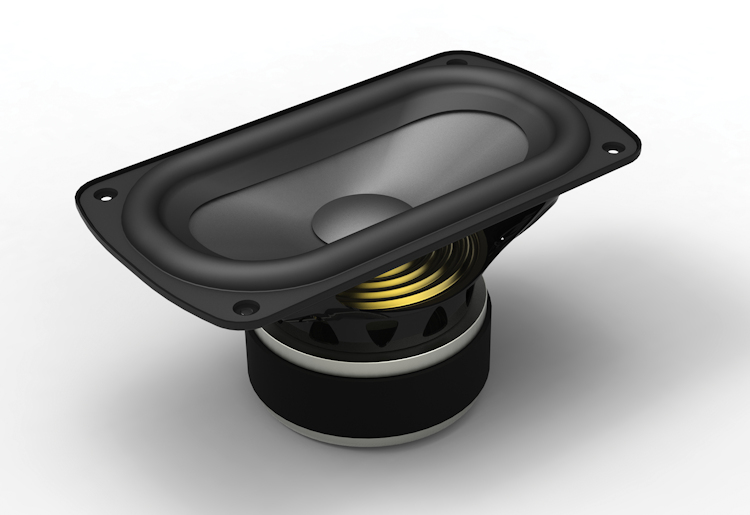

The pair of 5.25” upper-bass/midrange drivers are also revised with a polypropylene cone and new “focused field magnet structure” developed for the Reference Triton.
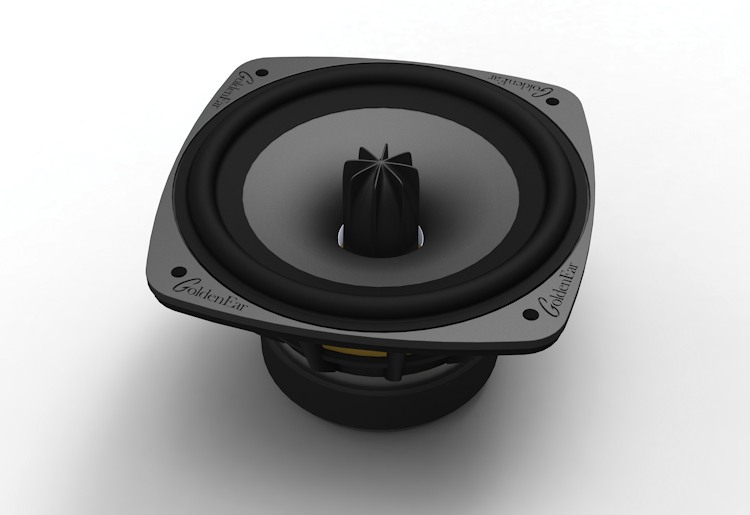
Not to suggest the star driver in the Triton line is the HVFR™ folded ribbon tweeter but it may be the standout in the array. It has 50% more neodymium magnet material over the previous tweeter design, again as developed for the Reference. GoldenEar likens this design to give more control and higher efficiency.

The rear bottom of the speaker houses the gold-plated speaker posts and LFE RCA jacks used in a theater setup where you want your processor to set the levels for the subwoofer output. Otherwise, the subwoofer level can be set with a rotary knob next to the speaker connections.
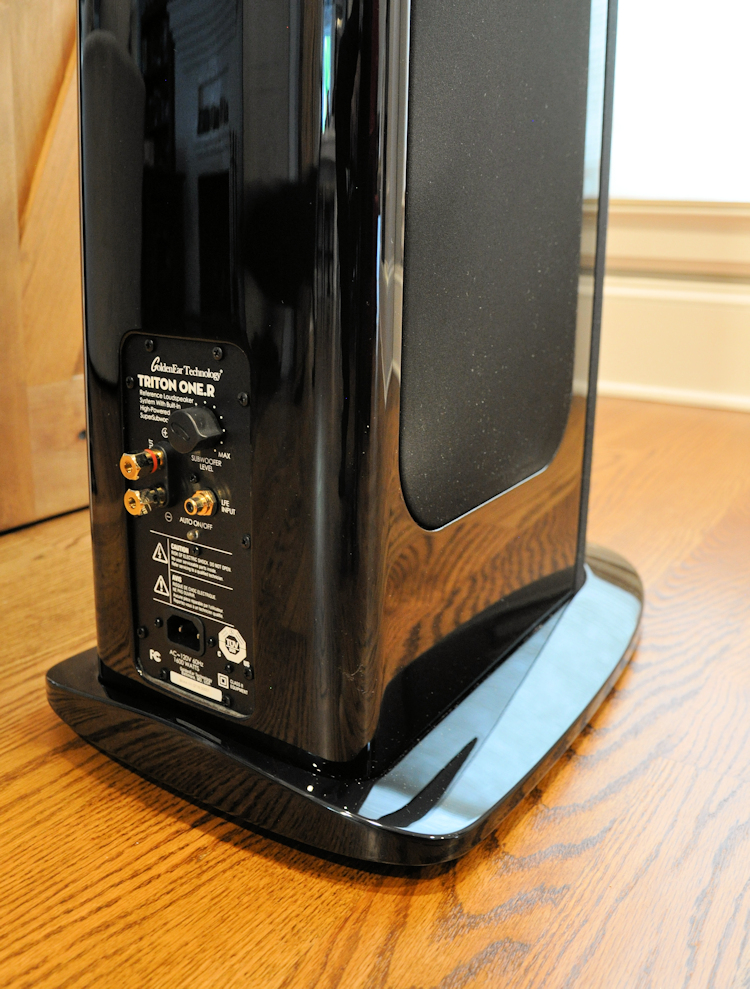
Like the previous Triton loudspeakers, I’ve reviewed; the Triton Reference, Triton One and Triton 2, placement for the One.R was just where the others were positioned – right where Sandy Gross put them.
Sandy consistently prescribes spacing the speakers as far apart as possible with a severe toe-in making the high frequencies converge just behind your head. What you may give up in the sound “width”, you more than makeup for in tonal balance, clarity and reduced early reflections in the room.
However, the Triton One.R can be forgiving in its placement, I actually played a bit, placing them closer together with less toe-in, even straight out. I asked Sandy for his thoughts.
“…In any event, one other point that is often not understood is that toe’ing the speakers in creates a wider sweet spot. This is because if the speakers are pointing straight ahead, if you move towards the left, for instance, you would be moving more directly in front of the left speaker, and it would tend to dominate. Another subtler point about toe-in, when the speaker is pointing directly at you, you will be getting a more coherent wavefront off the drivers, particularly the midrange drivers. If you can imagine, when the driver is pointed directly at you, you are equidistant from the left and right side of the driver, it is phase-aligned to pick an old term. When pointing straight ahead and you are off at an angle, it is something different.”
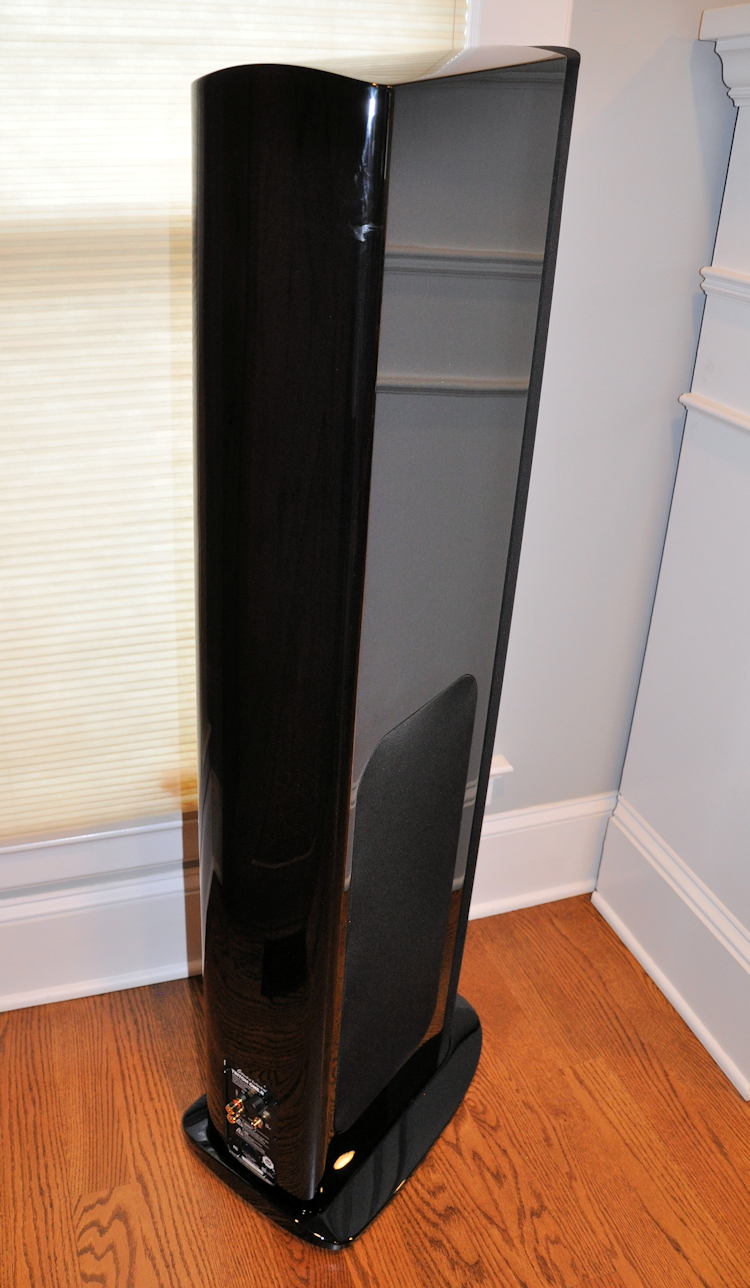
One last tidbit, my listening chairs are quite low, with my ear-height lower than “normal”, and it seems with the height of the large Tritons, I end up tilting the tall speakers forward a bit, perhaps as much as a 1/4” higher in the back. This helps the vertical alignment of the tweeter to my ears. Does that mean the Triton’s fail in any way listening off-axis? Not at all. What I may have experienced off-axis vertically in the Reference, seems to be gone from the One.R. Additionally, the fact that the One.R is shorter, lowers the tweeter height to my ear level.
The built-in subwoofer system on the large Triton allows you to set the room gain to taste. Starting around 12 o’clock or straight up, I did find myself adding a degree or two for more bass, adding just for more punch than normal as compared to the Reference. The LFE signal input option would allow your preamp to set the bass crossover. Since I have the Parasound Halo P6 preamplifier with bass management, I did experiment a bit but that may be a discussion for my forthcoming review. I also used the Parasound John Curl JC5 Halo amplifier. What I will say is that although the Halo amplifier is significantly more powerful than necessary for the highly sensitive Triton One.R, the speaker dynamically benefited with more punch and breadth to the sound.
For digital music, I used an Oppo UDP-205 player and for vinyl, a Marantz TT-15 S1 played through a Parasound JC 3 Jr phono preamplifier. My system includes Transparent Audio speaker interconnects and power cables. I also spent a lot of time with Tidal music played through my Mac Book using a Meridian Explorer 2, portable DAC.
Duke Ellington and His Orchestra provided my first significant listening with the Such Sweet Thunder record. Via a Meridian Explorer 2 in-line DAC feeding my MacBook, I did listen to the album through Tidal as well but found the vinyl version just a bit more engaging. This is an incredible recording considering it’s from 1957. The music was inspired by the work of William Shakespeare and commissioned by the Canadian Stratford Shakespeare Festival.
Wind instruments are open, airy and so organic. The clarinet, trombone, tenor saxophone, all richly textured and while the Triton One.R renders them full and powerful, there is still so much delicacy, never obnoxiously brassy, but metallic, nonetheless.
Track 5, Half The Fun on side B is almost erotic with the percussions melding with the lead clarinet and background trombones. The Triton One.R is right there, neither expressing the bass too much nor letting the clarinet sound shrill – seems just perfectly balanced.
Balance, probably the meat of any Triton speaker, but it seems especially true with the One.R. I can’t recall a speaker that presents the low, mid, and upper range so evenly. My Tidal account has been working overtime through this review, I hungrily searched for any Master Quality audio tracks. I found Tidal’s own playlists featuring a variety of genres.
Secrets Sponsor
Especially enjoyable is a classical series from Deutsche Grammophon 120, celebrating 120 years. Track after track, the One.R plays each gracefully, sweetly and delicate at times. And other times powerful and forceful when needed.
But all the time, balanced. Anne-Sophie Mutter playing Schubert: Forellenquintett – Piano Quintet In A Major, “The Trout” beautifully renders violins and piano, the One.R sets the chamber music spatially, dynamically.
The Triton One.R further expresses its range with the large bass drum opening the Prokofiev: Romeo and Juliet, Op. 64 – Dance of The Knights with depth and power yet transitions to the violin solo with a beautiful rhythm.
A jazzy number from Madeleine Peyroux, with her track We Might As Well Dance. The One.R brings out the heavy baseline with her rich voice. Background vocals blend beautifully while her voice is forward and breathy.
Lou Reed’s Raven album and particularly his Vanishing Act track is sublimely real on the Triton One.R. His voice is raspy, thick and again delicate, all at once. The piano fills the space around his voice and provides a counter to his melancholy. Only to end with some beautiful strings.
Tom Waits, What’s He Building?, is haunting with the One.R expressive of the percussions scattered around the soundstage.
Listen to Poisoned Rose by Elvis Costello and to hear how the One.R gives him a crooner-quality voice.
Finding more MQA Studio quality material in The Eagles playlist (sorry about that) – the playback is just so damn good. Musical instruments are nicely spaced and delineated while lead guitars aren’t shrill but decidedly crisp. The signature vocal harmonies of the Eagles portrayed by the One.R are natural, rich and sweet.
I’ll finish my listening review with a Gregorian Chant: Misereris omnium, Domine with the Sistine Chapel Choir and conductor Massimo Palombella. I’m struck by the depth of the space the One.R reaches.
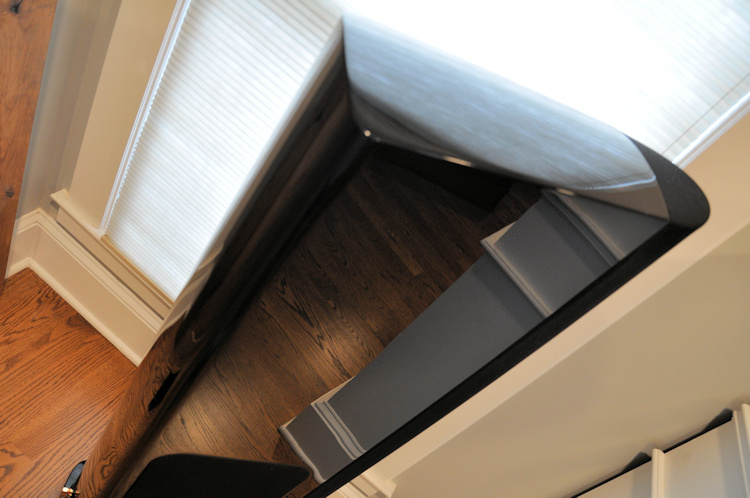
The Triton One.R completely changes the standards and definition of what is considered true high value in a speaker! Listening to the One.R is an elevated experience, at any price.
I had some significant discussions this past spring about measurements and their value when it comes to evaluating audio speakers. I know Secrets readers generally like seeing the results of frequency sweeps and off-axis responses and for the most part, so do I. But the question is really, do you trust what you hear? Do you need a computer and microphone to tell you whether what you hear is legitimate? Does it matter if the results of “good measurements” reinforce what you’re hearing? Don’t bad speakers just sound bad? Don’t good speakers just sound good?
As for the Triton One.R, I don’t need to know frankly how it measures, it doesn’t matter. I would be surprised if not shocked to learn it doesn’t measure well. Because to my ears, GoldenEar has solidly created a niche of products uniquely positioned in price, value, and performance that very few have achieved. The One.R may be the pinnacle, to date.
I don’t know if it’s pixie dust, secret sauce or simply, good sound engineering from a skilled, experienced group at GoldenEar, but whatever they put out seems to consistently hit the mark. Highly recommended. Enough that I got a pair for myself!


